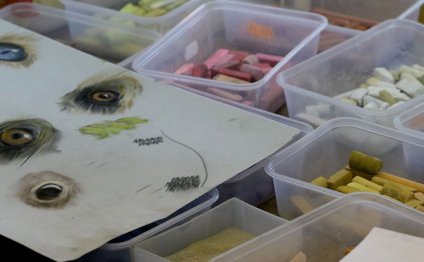
Painting in Spain
 Isolated by its rugged, mountainous terrain, Spain relied on foreign contacts to keep abreast of the most recent artistic developments. Although compositions and techniques might derive from Netherlandish or Italian sources, Spanish art retained an emotional intensity and religious fervor all its own.
Isolated by its rugged, mountainous terrain, Spain relied on foreign contacts to keep abreast of the most recent artistic developments. Although compositions and techniques might derive from Netherlandish or Italian sources, Spanish art retained an emotional intensity and religious fervor all its own.
The earliest Spanish paintings in the National Gallery belong to the era of Ferdinand of Aragon and Isabella of Castile, whose marriage united the kingdom. Netherlandish art exerted a pervasive influence, as can be seen in and Christ among the Doctors by an anonymous artist known as the Master of the Catholic Kings. The heraldic devices displayed in these biblical scenes most probably refer to the marriages in 1496 and 1497 of the Spanish monarch’s son and daughter (Juan and Juana of Castile) to the son and daughter (Philip the Fair and Margaret of Austria) of Maximilian I of Austria, thus forming an alliance with the Habsburgs.
Spain’s preoccupation with spiritual matters remained largely undiluted by the new humanistic ideas of the Italian Renaissance. In the wake of the religious division caused by the 16th-century Protestant Reformation, the Catholic Church initiated the Counter-Reformation, setting strict guidelines for artists, which required that they express the church’s dogma vividly in order to stir emotions and encourage piety and devotion. Born in Greece and shaped by years spent in Venice and Rome, El Greco employed flickering brushwork and elongated figures, derived from Italian mannerism, to form an emotional, idiosyncratic style that meshed perfectly with the intensity of Spanish spirituality. This can be seen in such radiant paintings as the
The 17th century’s interest in the material world fostered a new realism in painting and saw the introduction of a variety of secular subjects. Juan van der Hamen y León specialized in still life, and his Still Life with Sweets and Pottery depicts with succulent realism the sugary confections beloved by upper-class Spaniards. Bartolomé Esteban Murillo’s gifts as a storyteller are abundantly evident in The Return on the Prodigal Son, while his dramatic, theatrical style is in sharp contrast to the severe intensity of his near contemporary Francesco de Zurbarán, as seen in his Saint Lucy.
YOU MIGHT ALSO LIKE



Share this Post
Related posts
Painting in Italy
Since prehistoric times, Greeks, Etruscans and Celts have inhabited the south, centre and north of the Italian peninsula…
Read MorePainting in France
Pablo Picasso’s Head of a Young Woman, not allowed to leave Spain, was found on a boat in Corsica, French authorities have…
Read More





